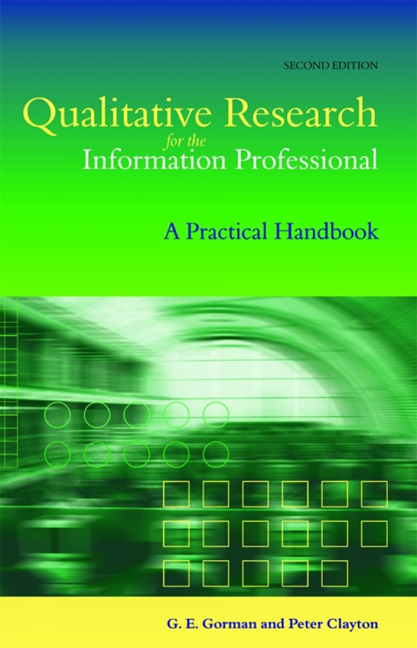Book contents
- Frontmatter
- Contents
- Tables, figures and research scenarios
- About the authors
- Preface to the second edition
- 1 The nature of qualitative research
- 2 Evaluating qualitative research
- 3 Qualitative research design in information organizations
- 4 Case studies in information organizations
- 5 Laying the foundations for fieldwork
- 6 Beginning fieldwork
- 7 Observation
- 8 Interviewing
- 9 Group discussion techniques
- 10 Historical investigation
- 11 Recording fieldwork data
- 12 Analysing qualitative data from information organizations
- 13 Writing qualitative research reports
- 14 Human resources in knowledge management: a case study
- Select bibliography
- Index
6 - Beginning fieldwork
Published online by Cambridge University Press: 08 June 2018
- Frontmatter
- Contents
- Tables, figures and research scenarios
- About the authors
- Preface to the second edition
- 1 The nature of qualitative research
- 2 Evaluating qualitative research
- 3 Qualitative research design in information organizations
- 4 Case studies in information organizations
- 5 Laying the foundations for fieldwork
- 6 Beginning fieldwork
- 7 Observation
- 8 Interviewing
- 9 Group discussion techniques
- 10 Historical investigation
- 11 Recording fieldwork data
- 12 Analysing qualitative data from information organizations
- 13 Writing qualitative research reports
- 14 Human resources in knowledge management: a case study
- Select bibliography
- Index
Summary
FOCUS QUESTIONS
• What criteria should be considered when selecting sites for an investigation?
• What criteria should be considered when selecting subjects for observation or interview?
• How do you gain access to a selected location?
• What is the purpose of a pilot study and preliminary data collection in the process of formulating a research plan?
• What is a broad research plan intended to achieve?
Stage 2: broad exploration
Having described the four steps of the foundation stage of fieldwork in infor ma - tion agencies, we are now ready to begin Stage 2. This involves broad exploration of sites and testing of methodologies. The first step in this stage is Step 5 (Steps 1 to 4 having been covered in Chapter 5). This step involves selecting locations and subjects, and within this the procedure for gaining access to libraries and participants. These are key procedures upon which many a project founders, so are given particularly detailed treatment. The next step, Step 6, deals with the blueprint phase of formulating a research plan. This is less problematic, although as pilot studies and preliminary data collection do have an impact on all remaining steps in qualitative investigation they must be conducted with care. Each of these steps is described in enough detail to enable you to follow it through in your own investigation.
In the pyramid model the broad exploratory stage of fieldwork builds upon the earlier, foundation stage of preliminary preparation (see Figure 3.3, Chapter 3, p. 38). In the recursive model (see Figure 3.2, again in Chapter 3, p. 37) it consists of the two steps that follow the four preparatory steps: selecting the locations and subjects, and formulating a research plan.
It is during the course of completing the two steps in this stage that researchers actually ‘get their hands dirty’ for the first time. That is, they make preliminary forays into the field in a search for suitable locations and subjects, investigate the possibilities and test data-collecting procedures.
- Type
- Chapter
- Information
- Qualitative Research for the Information ProfessionalA practical handbook, pp. 80 - 102Publisher: FacetPrint publication year: 2004



